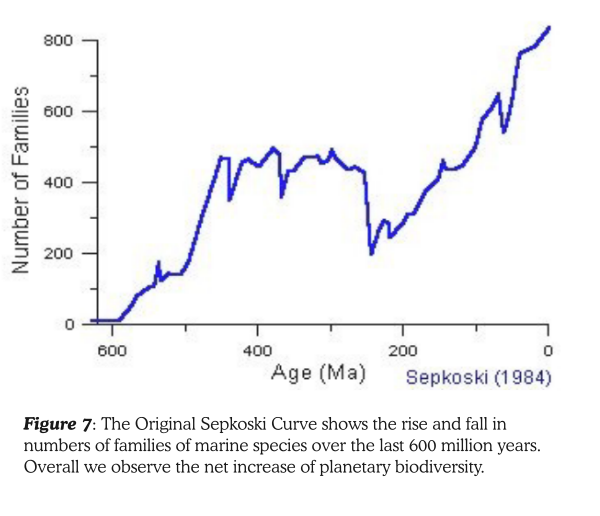Towards Biodiversity
Observe how the Earth has supported life and its diversification. — Earthen Ethic №5

In 1998, paleontologist Joseph Sepkoski completed a comprehensive database of marine life over the last 541 million years. The database compiled over 30,000 fossil genera, representing the finds and categorization of millions of species. By recording each genus’s appearance and disappearance in the fossil timeline, he was able to chart for how long each were active and when they died off. Sepkoski was particularly interested in showing the Earth’s great rises and falls in diversity — such as the explosion of life in the Carboniferous to the rise and fall of the dinosaurs. Indeed, his timeline of extinctions correlates directly with the dating of great meteors and volcanoes by geologists. However, just as important as showing declines in diversity, his curve rises — demonstrating a phenomenon far more fundamental. Over the history of the Earth the diversity of the biosphere has steadily increased.

OUR UNDERSTANDING OF THE EARTH'S two billion year journey from a barren planet to the thriving biosphere of today is laid out in Sepkoski's famous graph. The correlation between the greening of the biosphere and the rise in planetary biodiversity, presents us with a fifth principle of ecological contribution. Like our other principles, it is a phenomenon that we observe from the micro to the macro. In everything from cellular life to continental biomes, by tending its processes towards diversification, the Earth cultivated systems with an ever wider variety of participants. Soon, organisms and ecolosystems were making overlapping contributions, spiraling matter into ever more concentrated configurations and spiraling nutrients upwards to the benefit of all.
As ecosystems grew ever more diverse, they developed cascades of resiliency. With more and more overlapping participation, if one species should falter, another could take its place. Then, as more species joined in and found their niche, more and more cooperation emerged. The grazing of the gazelle aided the grass to grow stronger and to spread. Meanwhile, the grass’s calories powered both the gazelle and the wildebeest to wander, graze and fertilize. Steadily, matrices of cooperation and resiliency evolved in complexity and depth. The synchrony of countless life-cycles created a vast choir of ecological contribution and the song of life could soar during periods of stability and persist even after events of cataclysmic collapse.
As we strive to make our human enterprises green, the Earth’s example shows us the way forward. Just as the Earth tended it’s processes towards diversification, cooperation and resiliency, so too must we intend and achieve with ours. Only when the intention and the result of our process is the flourishing of life’s diversity is the principle of diversification met. Only then can our acts and enterprises be considered ecological contributions — and green.
Perhaps our most notable ecological enterprise is the cultivation of food.
Often when modern food is cultivated, it is done so in large fields in which the focus is the harvest of a single plant. In the case of corn, to maximize yield, herbicides and pesticides are frequently used to eliminate ‘competing’ species. In so far as this process has the intention and the result of restricting the species involved, it fails to embody the principle of supporting life’s diversification. As such, food grown this way cannot be considered an ecological contribution — nor green.
Around the Great Lakes of North America, the first nation of the Iroquois planted corn along with pumpkins and beans. The cultivation of these three plants together was so complimentary that they were known as the three sisters — providing shade, nitrogen and structure for each other. With sufficient support, the participation of insects, fungi and other plants did not detract from the yield, but added to it. Rather than being closed to diversity, the Iroquois spaces were open and invited participation. Rather than restrictive, it was tended to the benefit of all — corn, pumpkin, bean, humans and anyone else who willing to join the in the fray — thus fully embodying the principal of diversification.
When we evaluate our acts and enterprises we must thus ask: is our process open to the participation of other species? Does it vitalize the diversification of connected ecologies towards resiliency and cooperation? Only if a process is supporting life’s inherent tendency towards diversity can it be considered an ecological contribution.
But how exactly do we determine if our process is achieving this?
In his undertaking to understand ancient marine diversity, Sepkoski reviewed thousands of scientific journals by paleontologists and biologists to survey the number of species at the outset of an age and at its end. Likewise, our acts and enterprises must involve a similar assessment and survey. Fortunately we don’t need to worry about all the creatures of the ocean — just those touched by our particular process! Like Sepkoski, by surveying, naming and listing the species within the space and time of our processes we too can demonstrate diversification.
In this way, if a human enterprise hasn’t first assessed and gotten to know the participants of the space it touches, it fails to meet the principle of diversification out of hand. The naming and knowing of contributors — or not — expresses the depth of a process’s intention to supporting life. As we saw earlier, all of our modern processes occur within a petro-capital economy whose priority of profit supersedes the the well being of other species. The onus is on us to set and declare intentions that achieve and demonstrate otherwise — and learn the names and ways of our neighbours.
It’s a little like the last time you found yourselves gathering with a group of strangers — perhaps for a party, a team or a meetup around a common intention.
Was your name asked for? Was it written down and recorded? Was it spoken kindly and accurately? An open ecological space, like a warm human community, is one that welcomes and gets to know those who are there. As with human groups, it is those ecological communities that get know each other that thrive. After all, how can we work together if we don’t know the names and needs of our fellows? How can we assist each the other if we don’t know our respective preferences, skills and strengths?
Unlike the previous principle of net-subtraction, achieving the Earth’s way of diversification is simpler. No outset investments are needed to reduce grey impacts or enhance green ones. Putting out the welcome mat requires only courage.
Whereas achieving net-zero carbon and beyond is the result of a process, diversification is a property of the process. As such it is fundamentally relative. A rain-forest preserve, though it may host thousands of species, may fail the principle of diversification if it’s space (and thus the number of species it hosts) is reduced by government or industry. Meanwhile, a mono-crop farm that has for decades been restricting its space, can — with a courageous change of heart — on-ramp overnight onto the road of diversification.
Embodying the principle of diversity begins with the slightest pivot. By shifting our spaces from restricting to welcoming, the most desolate landscrapes of our petro-capital age are put on a road towards hosting the most dramatic regenerations.
For our planet, it’s never been about the number of species. Rather the ongoing effort to provide them a home. Following the Earth’s example, step by step, our human-only spaces can become common homes.

First, we assess. We observe in square meters just how much of our space has been restricted to humans and how much need not be any longer. We then take stock of what creatures are already with us — a list, a database, a registry ready to be ever expanded.
Second, we welcome. Slowly and steadily, our ratio of closed to open space can be increased. While the first tiny steps may seem trivial — planting a tree, adding some potted plants, building a bird feeder — what is key is our direction.
Third, we allow, guide and harvest. With our fellow participants accounted for and honored their efforts will be coupled with ours towards everyone’s benefit. Mindfully, we give our attention, gratitude and assistance. By allowing them to pursue their parameters of purpose, and by harvesting in a way that enriches everyone else, diversification will further manifest. In the branches of our first tree, birds will roost, the fruits enjoyed by us and all, and the seeds of the next trees will spread.
Fourth, we compensate. As more and more species join our space we will still need our human only spaces. For those closed spaces we must make, we expand an equivalent open one. A new cement foundation or paved parking can be matched with an equal green space. In this way, we can be sure to continue increasing our ratio of open:closed space and maintain our overall welcome. Little by little, to make up for our grey-spaces we can let our lawns go to gardens, replace fences with hedges, our old factories with fields.
And finally… we discover!
With our door wide open, the full force of the Earth’s tendency towards diversity can express itself and re-vitalize our spaces. As our life-lists focus our attention to our ecological community, we will find that there were far more creatures at work with us than we ever imagined — species small and mighty enriching the soil and cleaning the air. As we discover creatures that have long been our unnamed friends, their addition become a legitimate boon for our life-lists ratios— and an indication of a phenomenon even more profound unfolding.
As our garden green spaces transform to forests, and as our forests transform to wild and wondrous sanctums, so too is the consciousness of our connection to it all blossoming like a spring flower. As we will see in our next Earthen Ethic, just as important as diversification is our awareness of our place in the process itself.
See how I keep track of track and disclose the biodiversity impact of Earthen:




